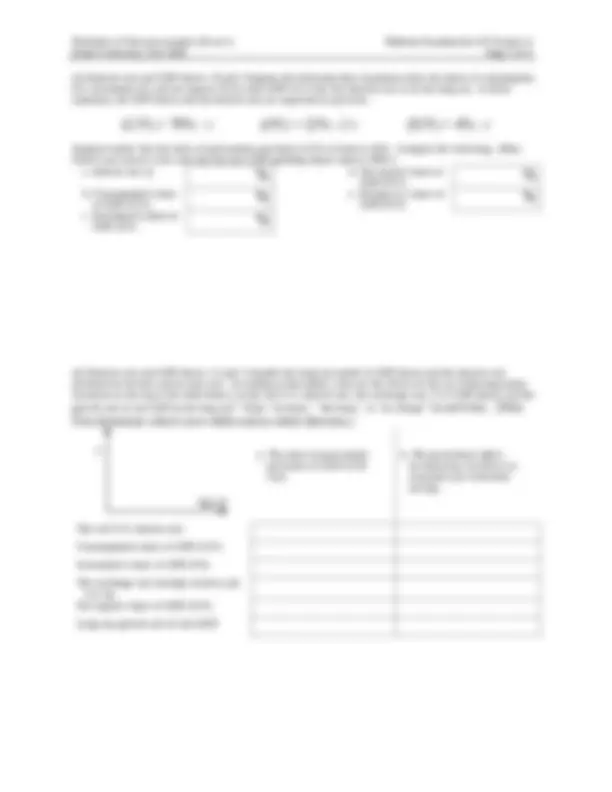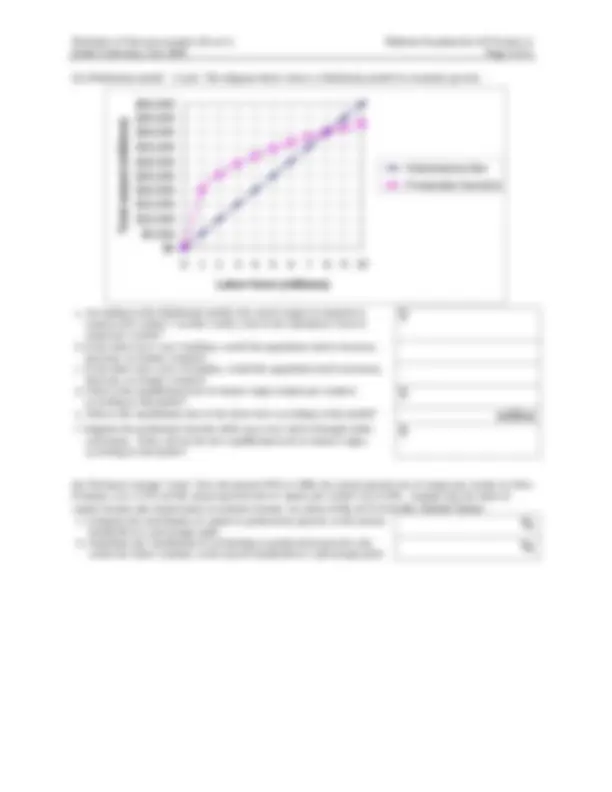





Study with the several resources on Docsity

Earn points by helping other students or get them with a premium plan


Prepare for your exams
Study with the several resources on Docsity

Earn points to download
Earn points by helping other students or get them with a premium plan
Community
Ask the community for help and clear up your study doubts
Discover the best universities in your country according to Docsity users
Free resources
Download our free guides on studying techniques, anxiety management strategies, and thesis advice from Docsity tutors
Material Type: Exam; Professor: Boal; Class: PRINCIPLES OF MACROECONOMICS; Subject: Economics; University: Drake University; Term: Fall 2004;
Typology: Exams
1 / 6

This page cannot be seen from the preview
Don't miss anything!




Principles of Macroeconomics (Econ 1) Signature: Drake University, Fall 2004 William M. Boal Printed name:
INSTRUCTIONS: This exam is closed-book, closed-notes. Simple calculators are permitted, but not graphing calculators or calculators with alphabetical keyboards. Point values for each question are noted in brackets. I. MULTIPLE CHOICE: Circle the one best answer to each question. [2 pts each—32 pts total] (1) According to the aggregate production function, potential GDP is determined by all of the following except a. total spending. b. the size of the labor force. c. the size of the capital stock. d. technology. (2) Suppose the capital stock at the beginning of 2004 is $8 trillion. Also suppose that during 2004, gross investment is $1.5 trillion and depreciation is $1.2 trillion. Then the capital stock at the beginning of 2005 will be a. $8 trillion. b. $8.3 trillion. c. $9.5 trillion. d. $10.7 trillion. (3) Investment spending is a. positively related to the real interest rate. b. negatively related to the real interest rate. c. unrelated to the real interest rate. d. cannot be determined from information given. (4) If a person does not have a job, and last looked for work two months ago, that person would be classified by the Bureau of Labor Statistics as a. employed. b. unemployed. c. out of the labor force. d. cannot be determined from information given. (5) "Job rationing" theories of unemployment predict that unemployment could be reduced if a. wages were increased. b. wages were reduced. c. workers were notified of plant closings in advance. d. government helped match unemployed workers with employers. (6) The last few decades have seen a decline in the labor-force participation rate of a. women only. b. men only. c. both women and men. d. none of the above. (7) Since 1700, long-run growth rates of real GDP per capita in the fastest-growing countries have a. remained about zero. b. remained constant, though positive, from one century to the next. c. decreased from one century to the next. d. increased from one century to the next. (8) A country experiences faster "embodied" technical change, the a. more workers ("bodies") are available to use it. b. faster the rate of investment spending. c. more training workers receive. d. larger the existing capital stock already in place. (9) "Human capital" means a. people-friendly businesses. b. ergonomically designed equipment. c. education and training. d. retirement savings plans. (10) A new idea for designing cars could potentially be used by many car producers at once. Therefore, this new idea is a. a nonexcludable good. b. a nonrival good. c. a private good. d. a transfer.
Drake University, Fall 2004 Page 2 of 6 (11) The three essential functions of money include all of the following except a. method for reducing government deficits. b. medium of exchange. c. store of value. d. unit of account. (12) A key function of any central bank is to a. make loans to consumers. b. promote investment spending by buying corporate bonds. c. control the supply of money. d. design and print currency. (13) When banks keep reserves on deposit with the Federal Reserve, those funds earn an interest rate a. greater than the market rate. b. equal to the market rate. c. slightly below the market rate. d. of zero. (14) According to the quantity equation, if the money supply grows at exactly the same rate as the growth rate of real GDP, the inflation rate will be a. positive. b. negative (deflation). c. zero. d. cannot be determined from information given. (15) Hyperinflation is caused by excessive a. government spending. b. investment. c. growth of the money supply. d. population growth. (16) Most economists believe that the long-run relationship between unemployment and inflation is represented by which curve below? II. PROBLEMS: Please insert your answer to each question in the box provided. Feel free to use the margins for scratch work—only the answers in the boxes will be graded. Work carefully—partial credit is not normally given for questions in this section (1) [Labor force: 4 pts] The Bureau of Labor Statistics reported that in August 2004, 139.7 million people were
a. Compute the unemployment rate (to the nearest tenth of a percentage
b. Compute the labor force participation rate (to the nearest tenth of a
(2) [Interest rate: 4 pts] Suppose the interest rate is 2%. a. The opportunity cost of $1 of consumption today is how many dollars of
b. The opportunity cost of $1 of consumption next year is how many dollars of consumption today?
Inflation Unemployment
Inflation Unemployment
Inflation Unemployment
Inflation Unemployment
Drake University, Fall 2004 Page 4 of 6 (5) [Malthusian model: 12 pts] The diagram below shows a Malthusian model of economic growth.
a. According to this Malthusian model, how much output is required to sustain each worker? In other words, what is the subsistence level of output per worker?
b. If the labor force were 4 million, would the population tend to increase, decrease, or remain constant? c. If the labor force were 10 million, would the population tend to increase, decrease, or remain constant? d. What is the equilibrium level of annual wages (output per worker) according to this model?
f. Suppose the production function shifts up as new land is brought under cultivation. What will be the new equilibrium level of annual wages, according to this model?
(6) [Technical change: 4 pts] Over the period 1970 to 1990, the annual growth rate of output per worker in West Germany was 2.12% and the annual growth rate of capital per worker was 4.35%. Assume that the share of
a. Compute the contribution of capital to productivity growth, to the nearest hundredth of a percentage point.
b. Contribute the contribution of technology to productivity growth, also
Drake University, Fall 2004 Page 5 of 6 (7) [Money: 8 pts] The U.S. Federal Reserve and the U.S. Treasury Department reported the following data for December 2001. [Hint: Some of the data are extraneous and not needed for this problem.] Currency $582 billion Bank reserves $41 billion Consumer credit $556 billion Travelers checks, demand deposits, and other checkable deposits $597 billion Federal debt held by public $3,366 billion Savings deposits, small time deposits, money-market mutual funds, and other deposits on which check writing is limited or not allowed $4,269 billion
d. Assume banks hold zero excess reserves. Compute the money multiplier for “M1” to the nearest tenth. (8) [Money multiplier: 4 pts] Suppose the required reserve ratio were 0.05 and the Federal Reserve increased bank reserves by $10 billion. a. If everyone held money in the form of deposits only (no currency) by how much would the money supply increase?
b. If everyone held $0.20 in currency for every $1.00 in deposits (that is, the ratio of currency to deposits were 0.2) by how much would the money supply increase?
(9) [Money velocity: 2 pts] According to the Federal Reserve, the stock of money (M1) was about $1,166 billion in the fourth quarter of 2001, while according to the U.S. Bureau of Economic Analysis, U.S. GDP was $10, billion. Compute the velocity of M1 to the nearest tenth. (10) [Quantity equation: 2 pts] According to the U.S. Bureau of Economic Analysis, U.S. real GDP grew at an annual rate of 3.5% from 1975 to 1985, while according to the Federal Reserve, the stock of money (M2) grew at an annual rate of 9.4%. Assuming the velocity of money were constant, what should have been the average rate of inflation, according to the quantity equation?